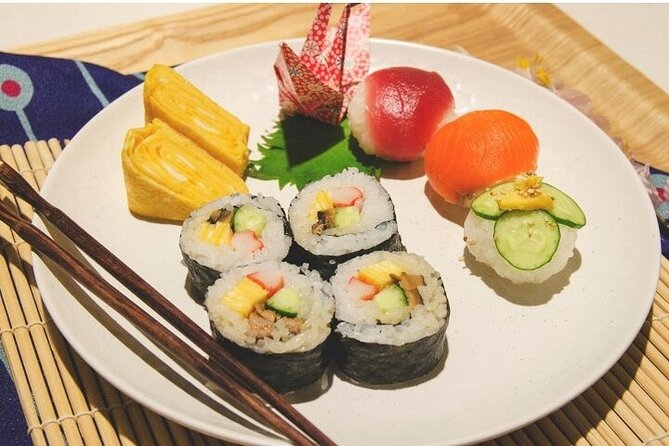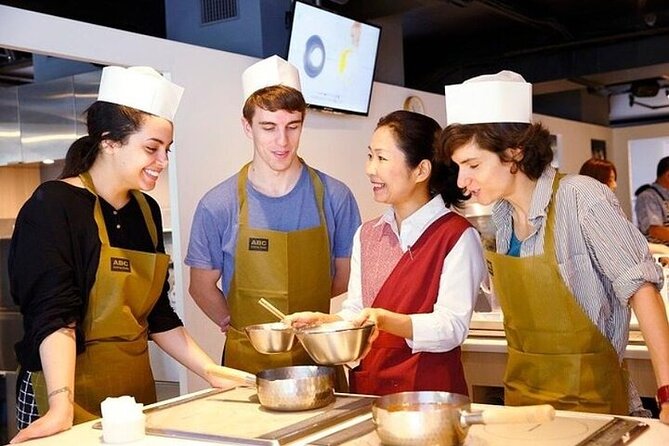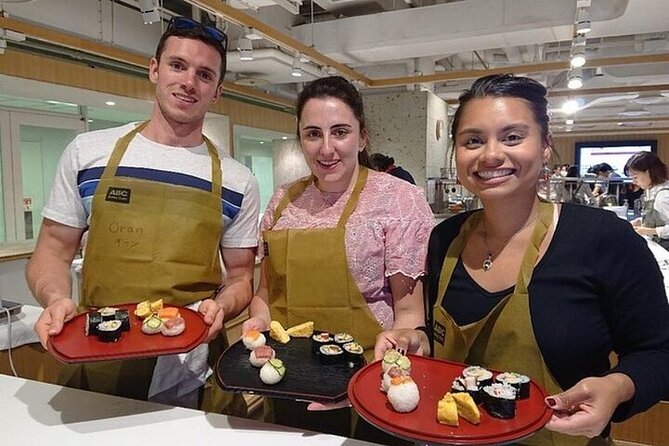Fukuoka, a vibrant city in Japan, is home to the country’s leading culinary school. Here, visitors can embark on a sushi-making adventure, honing their skills under the guidance of expert instructors. With a small group size, the hands-on class offers personalized attention, allowing participants to craft rolled sushi, tamagoyaki, and a traditional clear soup. The experience promises a delightful blend of culinary expertise and culture, setting the stage for an unforgettable gastronomic journey.
Key Points

- Immersive sushi-making class held at a leading culinary school in Fukuoka, Japan, with a focus on rolled sushi, tamagoyaki, and clear soup.
- Small group size of up to 6 travelers ensures personalized attention during the cooking lesson.
- Lunch with a vegetarian option and an optional fortune slip are included in the experience.
- Convenient location near Nishitetsu Tenjin Station and Tenjin Bus Center, with accessibility via public transportation.
- Cancellation policy allows free cancellations up to 24 hours before the class, with a full refund for unavoidable circumstances.
Overview of the Cooking Class

The sushi cooking lesson takes place in Fukuoka, Japan, at the country’s leading culinary school.
The class teaches participants how to make rolled sushi, tamagoyaki (Japanese egg roll), and clear soup. The group size is limited to a maximum of 6 travelers to ensure personalized attention.
Based on 2 reviews, the class has an impressive 4.5-star rating.
The cooking lesson includes lunch with a vegetarian option, as well as the use of an apron, kitchen towel, and chef’s hat. Participants can also enjoy a fortune slip for a small additional fee.
Here are more great tours and experiences we've reviewed in Fukuoka
Inclusions and Amenities

As part of the sushi cooking lesson, participants enjoy a included lunch with a vegetarian meal option available.
The cooking studio also provides the following amenities:
- Use of an apron, kitchen towel, and chef’s hat to wear during the lesson
- Bottled water to keep hydrated
- A fee for a fortune slip (omikuji) for a bit of extra fun
- Access to food and beverages at the cooking studio to refuel after the hands-on cooking experience.
These inclusions and amenities ensure a well-rounded, comfortable, and engaging sushi cooking lesson in Fukuoka.
Meeting and Pickup Details
Participants meet at the Solaria Stage Building, located at 2-chōme-11-3 Tenjin, Chuo Ward in Fukuoka.
The cooking studio is on the 5th floor, next to Nishitetsu Tenjin Station and Tenjin Bus Center. The class returns to the original meeting point after the experience.
Public transportation is accessible, with the nearest subway stations being Tenjin or Tenjin Minami.
Late arrivals will result in cancellation without a refund, so participants are advised to arrive on time.
Participation Guidelines
A minimum of 2 guests is required for the sushi cooking class to run.
Adult pricing applies to all travelers, and the minimum height requirement is 130 cm (4.2 ft). The class isn’t wheelchair accessible and isn’t recommended for pregnant travelers or those with serious medical conditions.
Infants must sit on laps, and no strollers or luggage are allowed.
The experience involves:
- Sushi rolling
- Tamagoyaki (Japanese egg roll) preparation
- Clear soup making
Casual clothing and comfortable shoes are recommended for this hands-on cooking lesson.
Cancellation and Additional Information
Travelers can cancel their reservation for the sushi cooking class free of charge up to 24 hours before the experience starts. If they must cancel due to unavoidable circumstances, they will receive a full refund. Rescheduling requests, however, are not eligible for a refund. Plus, photos taken during the class may be published on the provider’s website and social media. Casual clothing and comfortable shoes are recommended, and attendees should arrive on time as late arrivals will result in cancellation without a refund.
| Cancellation Policy | Refund Eligibility | Rescheduling | Photography | Attire |
|---|---|---|---|---|
| Free up to 24 hours | Full refund | No refund | May be used | Casual |
| before experience | for unavoidable | for requests | on website | and |
| starts | circumstances | and social | comfortable | |
| media | shoes | |||
Want to bring Fukuoka's flavors home? More hands-on cooking experiences we cover
Sushi Preparation
During the sushi cooking lesson, students learn the proper techniques for preparing rolled sushi, or maki-zushi.
They first learn to properly spread and season the sushi rice. Next, they carefully arrange the fillings, such as:
- Fresh fish
- Vegetables
- Omelets
Students then tightly roll the sushi using a bamboo mat, ensuring the fillings are evenly distributed.
Finally, they learn to slice the rolled sushi into bite-sized pieces using a sharp knife.
With guidance from the expert chef, students gain the skills to recreate authentic Japanese sushi at home.
Tamagoyaki (Japanese Egg Roll)
Along With rolled sushi, the cooking lesson also covers the preparation of tamagoyaki, a beloved Japanese egg dish. Tamagoyaki is a sweet, rolled omelet made by layering thin egg crepes. Participants will learn the techniques to create this delicate and fluffy Japanese specialty.
| Step | Description |
|---|---|
| 1 | Beat eggs with dashi, mirin, and sugar until well combined. |
| 2 | Heat a rectangular pan and lightly grease with oil. |
| 3 | Pour a thin layer of egg mixture and roll the egg into a cylinder. |
| 4 | Repeat the process, adding more egg layers to create the tamagoyaki. |
| 5 | Slice the tamagoyaki and serve warm. |
Clear Soup
After preparing the rolled sushi and tamagoyaki, participants in the cooking class will also learn how to make a clear soup, a staple in traditional Japanese cuisine.
The clear soup, known as "suimono," features a delicate, transparent broth made from dashi, soy sauce, and mirin.
Guests will learn to:
- Select the right ingredients, such as kombu (kelp) and bonito flakes, to create the umami-rich dashi base.
- Properly season the broth with soy sauce and mirin for a balanced flavor.
- Garnish the soup with simple, seasonal ingredients like a slice of lemon or a sprinkle of chopped green onions.
Frequently Asked Questions
Can Participants Keep the Apron, Towel, and Chef’s Hat After the Class?
The apron, towel, and chef’s hat are provided for use during the cooking class but they’re not items participants can keep afterwards. They are returned to the studio at the end of the experience.
What Is the Dress Code for the Cooking Class?
The cooking class recommends casual clothing and comfortable shoes. Participants don’t get to keep the apron, towel, and chef’s hat after the class.
Is There a Minimum Age Requirement for Participants?
The overview does not mention a minimum age requirement, but it states that the activity is not recommended for infants. Participants must meet the minimum height of 130 cm (4.2 ft) to participate in the cooking class.
Are Vegetarian or Gluten-Free Ingredients Available for the Sushi or Soup?
Yes, the cooking class offers a vegetarian meal option. They can accommodate dietary restrictions like vegetarian or gluten-free preferences for the sushi and soup menu items upon request.
Can Participants Bring Their Own Cameras or Phones to Take Photos During the Class?
Participants are welcome to bring their own cameras or phones to take photos during the class. The provider encourages guests to document their cooking experience and share it on social media, as long as they don’t disrupt the lesson.
The Sum Up
The sushi-making class at Fukuoka’s leading culinary school provides a hands-on, personalized experience to learn the art of traditional Japanese cuisine. With a small group size, participants can enjoy tailored instruction while creating rolled sushi, tamagoyaki, and clear soup. The class includes a delicious lunch and cultural touches, making it a delightful culinary adventure in the heart of Japan.
More Tour Reviews in Fukuoka
- Fukuoka Tour: Sacred Island of Munakata and Heritage Sites!
- Kyushu 9-Hour Chartered Day Trip| Fukuoka
- Fukuoka: Itoshima, Angels Wings, & Sake Brewery Private Tour
- Customizable Walking Tour With Ramen Tasting and Local Guide
- Fukuoka Tour: Demon Slayer-Inspired With Shrine Visits
- Fukuoka Private Custom Tour With Local Guide
Not for you? Here's more things to do in Fukuoka we have recnetly reviewed
- 3 Best Shopping Tours In Fukuoka
- 4 Best Full-Day Tours In Fukuoka
- 23 Best Cruises And Boat Tours In Fukuoka
- 7 Best Food Tours In Fukuoka
- 8-Day ONE WAY Bus Tour to Fukuoka From Osaka via SHIKOKU
- 6-Day Private Tour to Kyoto via Fukui From Fukuoka With Bus
- 5-Day ONE WAY Bus to North Hyogo From Fukuoka to Hiroshima
- 3 Day ONE-WAY BUS Tours to Fukuoka From Osaka via SANYO
- 3-Day ONE WAY Bus Tour to Hiroshima via SANIN From Fukuoka
- 3 Day One-Way Tour to Osaka From Fukuoka via SANYO With Bus
- *Stay at Beppu, 2-Day Bus Tour to Takachiho From Fukuoka
- Day Trip Bus Tour From Fukuoka to Tunoshima, Yamaguchi
